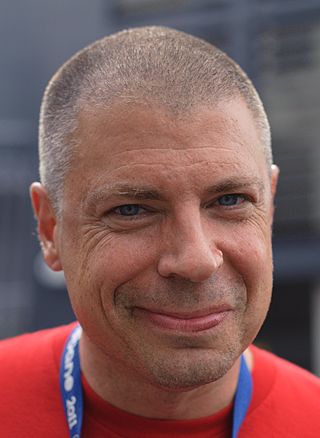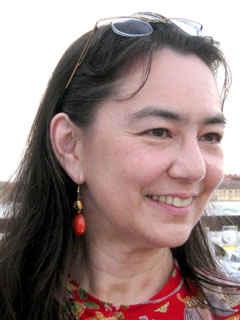
Virtual reality (VR) is a simulated experience that employs 3D near-eye displays and pose tracking to give the user an immersive feel of a virtual world. Applications of virtual reality include entertainment, education and business. VR is one of the key technologies in the reality-virtuality continuum. As such, it is different from other digital visualization solutions, such as augmented virtuality and augmented reality.

VRML is a standard file format for representing 3-dimensional (3D) interactive vector graphics, designed particularly with the World Wide Web in mind. It has been superseded by X3D.

Brenda Laurel is an American interaction designer, video game designer, and researcher. She is an advocate for diversity and inclusiveness in video games, a "pioneer in developing virtual reality", a public speaker, and an academic.

Mark D. Pesce is an American-Australian author, researcher, engineer, futurist and teacher.

Rebecca Allen is an internationally recognized digital artist inspired by the aesthetics of motion, the study of perception and behavior and the potential of advanced technology. Her artwork, which spans four decades and takes the form of experimental video, large-scale performances, live simulations and virtual and augmented reality art installations, addresses issues of gender, identity and what it means to be human as technology redefines our sense of reality.

Virtual art is a term for the virtualization of art, made with the technical media developed at the end of the 1980s. These include human-machine interfaces such as visualization casks, stereoscopic spectacles and screens, digital painting and sculpture, generators of three-dimensional sound, data gloves, data clothes, position sensors, tactile and power feed-back systems, etc. As virtual art covers such a wide array of mediums it is a catch-all term for specific focuses within it. Much contemporary art has become, in Frank Popper's terms, virtualized.

Immersion into virtual reality (VR) is the perception of being physically present in a non-physical world. The perception is created by surrounding the user of the VR system in images, sound or other stimuli that provide an engrossing total environment.
A projection augmented model is an element sometimes employed in virtual reality systems. It consists of a physical three-dimensional model onto which a computer image is projected to create a realistic looking object. Importantly, the physical model is the same geometric shape as the object that the PA model depicts.

Tony Parisi, one of the early pioneers in virtual reality and the metaverse, is an entrepreneur, inventor and developer of 3D computer software. The co-creator of Virtual Reality Modeling Language (VRML), he has written books and papers on the future of technology. He works on WebGL and WebVR and has written two books on the former, and an introductory book on virtual reality programming. He is the chief strategy officer at Lamina1. Parisi is also a musician, composer and producer working on multiple projects.
OZ Virtual was a 3D world viewer created by OZ Interactive that enabled real-time collaboration communications in shared spaces on the Internet with a strong focus on creative content production.

Diane Gromala is a Canada Research Chair and a Professor in the Simon Fraser University School of Interactive Arts and Technology. Her research works at the confluence of computer science, media art and design, and has focused on the cultural, visceral, and embodied implications of digital technologies, particularly in the realm of chronic pain.

Sketchfab is a 3D asset website used to publish, share, discover, buy and sell 3D, VR and AR content. It provides a viewer based on the WebGL and WebXR technologies that allows users to display 3D models on the web, to be viewed on any mobile browser, desktop browser or Virtual Reality headset.

Tamiko Thiel is an American artist, known for her digital art. Her work often explores "the interplay of place, space, the body and cultural identity," and uses augmented reality (AR) as her platform. Thiel is based in Munich, Germany.
VREAM, Inc. was a US technology company that functioned between 1991 and 1996. It was one of the first companies to develop PC-based software for authoring and viewing virtual reality (VR) environments.

A virtual reality headset is a head-mounted device that uses 3D near-eye displays and positional tracking to provide a virtual reality environment for the user. VR headsets are widely used with VR video games, but they are also used in other applications, including simulators and trainers. VR headsets typically include a stereoscopic display, stereo sound, and sensors like accelerometers and gyroscopes for tracking the pose of the user's head to match the orientation of the virtual camera with the user's eye positions in the real world.
Tilt Brush is a room-scale 3D-painting virtual-reality application available from Google, originally developed by Skillman & Hackett.
OpenXR is an open-source, royalty-free standard for access to virtual reality and augmented reality platforms and devices. It is developed by a working group managed by the Khronos Group consortium. OpenXR was announced by the Khronos Group on February 27, 2017, during GDC 2017. A provisional version of the standard was released on March 18, 2019, to enable developers and implementers to provide feedback on it. On July 29, 2019, OpenXR 1.0 was released to the public by Khronos Group at SIGGRAPH 2019.

A virtual reality game or VR games is a video game played on virtual reality (VR) hardware. Most VR games are based on player immersion, typically through head-mounted display unit or headset with stereoscopic displays and one or more controllers.
Monika Fleischmann is a German research artist, digital media scientist, and curator of new media art working in art, science, and technology. Since the mid-1980s she has been working collaboratively with the architect Wolfgang Strauss. As part of their research in New Media Art, Architecture, Interface Design and Art Theory, they focus on the concept of Mixed Reality, which connects the physical with the virtual world.
Monika Fleischmann and Wolfgang Strauss are renowned German new media artists. Since the mid-1980s, they have been instrumental in bridging the gap between new media art, computer science and knowledge art. Internationally recognized for their work in interactive environments, virtual reality (VR), mixed reality (MR), and knowledge discovery (KD), they are considered pioneers in new media art, community building and integrating transdisciplinary practices.






















